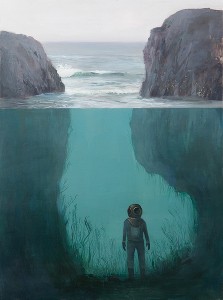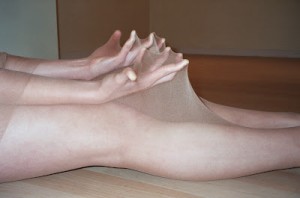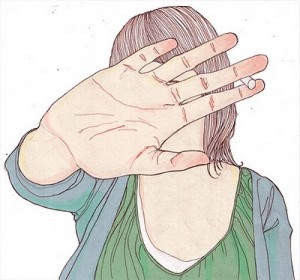A series of talks by Michael Stone about chapter 3 of The Yoga Sutra a text written by mysterious author(s) often named Patanjali in the second century. Notes by MH include reveries and imaginings. Centre of Gravity Fall 2011. www.centreofgravity.org
Rollo May, the American existentialist psychologist once wrote: “It is an ironic habit of human beings to run faster when we have lost our way.” How many of us want to live simpler lives? Coming here and sitting still is part of a process of touching our foundation, coming back to what we value.
Chapter three of The Yoga Sutra has some of the most detailed and precise descriptions of what happens during meditation. Helpfully, it is written in Sanskrit, a language that has many words to describe these states.
Dharana
Last week we explored dharana, the practice of meditation where there is immediacy and our attention is yoked to a field that is being observed. It is the sixth limb of yoga, in which we bond attention to a field, for example the movement of the breath, or the movements of a sensation. Through this bonding attention and the field become the same thing. When that happens it is called meditation. You become aware of a field that is moving – how do you meditate on a thought that is moving? The you that is aware is also changing. Or as Dogen puts it: when you practice, the other shore comes to you.
Line 2: “In meditative absorption, the entire perceptual flow is aligned with that object.”
Pratyaya
Pratyaya means re-presentation. You become one with the field through your subjectivity. It’s not objective. You’re still filtering your experience, the attention span, the organs of the body, are still filtering what you’re experiencing. You’re not merging.

Boredom
When something’s happening in your day and boredom arises: can you be one with boredom? If the field is boredom, can you yoke attention to the field of boredom? Dogen said: For the time being you can be on top of a mountain or at the bottom of an ocean. For the time being I’m bored. In my experience, there’s no mood that lasts for more than five minutes. Anne Carson: “If not for moods we would be continuous with the world.”
Patanjali calls this experience dharana – “concentration (dharana) can yoke its orientation to any chosen object or field. Once bodymind stillness has deepened sufficiently, Patanjali observes, an unprecedented fixity of attention becomes possible. This is because steady observation of the body sitting (asana) and breathing (pranayama) is itself powerfully concentrative, and one of its primary effects is to reveal the stunning distractibility afflicting the usual modes of consciousness… The effortless effort of abhyasa manifests here as the effort both to focus and to return from distraction, while the will not to react (vairagya) is the mechanism through which distractibility is attenuated. Concentration, a yogic action, and withdrawal of the senses, an effect, are interdependent, each arising with and supporting the other.” (Chip Hartranft)
When the word dharana goes to China it becomes Ch’an and in Japan it becomes Zen, all these words mean or refer to meditation. And each of them bears this underlying question: can I be one with this experience, this field?

Koan
The way we’re going to study The Yoga Sutra is to go one line at a time, and to use a Zen koan to break it open. When Yaoshan was sitting in meditation a monk asked him, “What are you thinking about when you’re sitting in such quiet composure?” Youshan replied, “I think not-thinking.” “How do you think not-thinking?” “Non thinking.”
Brad Warner, Tricycle Magazine: “If you start really paying attention to your own thought process—I’m talking here about the process itself and not just the contents of the individual thoughts that make it up—you’ll notice that thoughts don’t just go on and on continuously. There are little spaces between them. Most of us tend to habitually try and fill these spaces up with more thoughts as fast as we possibly can. But even the best of us can’t fill them all, so there are always little gaps. See, you might say that there are two basic kinds of thought. There are thoughts that pop up unannounced and uninvited in our brains for no reason we’re able to discern. These are just the results of previous thoughts and experiences that have left their traces in the neural pathways of our brains. You can’t do much to stop these, nor should you try. The other kind of thought is when we grab on to one of these streams of energy and start playing with it… To practice “thinking not thinking,” all you need to do is ignore the first kind of thoughts and learn how not to instigate the second. This is easier said than done, of course.”
Sometimes we like to make the realm of non-thinking into something narrow, but this koan is inviting us to touch the realm of non-thinking, to make a home there. Underneath our life is a much deeper life, how can we come out of the small, narrow, determined package of a life that is so familiar? Everything happens in the realm of non-thinking. The sun comes up. The squash grows. My hand was stung by a wasp while sleeping. I became so angry, thoughts about my landlord proliferated until I realized that body chemicals and organ secretions might be causing anger.
It’s like when you wake up in the morning with a heavy dream. If you try to analyze it you don’t kill the dream, you kill the experience of non-thinking. How can try not to control the non-thinking realm?

Map
Here is a map for the trek into the non-thinking realm.
IDEAS – THOUGHTS – IMAGES – SENSATIONS.
When you can loosen the grip around ideas they might begin to appear as thoughts, when thoughts quiet, and you can allow them to arise and pass away without being carried off by them then pictures can appear (even: visions, immaculate conceptions, temporary visitations), but don’t have to hang onto these either, if these can be allowed to come and go then there is a level of sensations. And after sensations?
When language fades images can become very vivid. Sometimes we attach importance to them because they seem like not thinking. But they’re a kind of picture language.
In this model of consciousness and meditation, Patanjali is arguing for the value of subjectivity. Touching the realm of non-thinking brings us towards sensation and direct experience.
Divisions
In his later years Carl Jung came up with an interesting theory around multiple personalities. We all divide our experiences, we compartmentalize parts of ourselves that we like and don’t like. In psychoanalytic terms this is called splitting. Sometimes the splitting can be so extreme, Jung theorized, that these aspects of ourselves can develop their own egos. And the suggested cure? To give each ego enough space, and ground them in relationship.
Trash
The Buddha wanted his monks to creates robes out of material that had been discarded — touched by animals or menstruation, ruined through misuse or carelessness. The things that we discard are holy. When these robes are too shredded to be worn these materials can be used for cleaning. And when they’re too shredded even for cleaning they can be used as something like rebar in concrete. What do you wear? Whatever is discarded.
In his later years Carl Jung came up with an interesting theory around multiple personalities. We all divide our experiences, we compartmentalize parts of ourselves that we like and don’t like. In psychoanalytic terms this is called splitting. Sometimes the splitting can be so extreme, Jung theorized, that these aspects of ourselves can develop their own egos. And the suggested cure? To give each ego enough space, and ground them in relationship.
Trash 2
The Buddha wanted his monks to creates robes out of material that had been discarded — touched by animals or menstruation, ruined through misuse or carelessness. The things that we discard are holy. When these robes are too shredded to be worn these materials can be used for cleaning. And when they’re too shredded even for cleaning they can be used as something like rebar in concrete. What do you wear? Whatever is discarded.
In meditation the field is not separate from attention. Anything in the field can be integrated into attention, even what has been discarded.
Several years ago I was going through a painful separation and I told my editor that I was having a hard time finishing a new book, and she said, “Oh, you’re going through a separation, isn’t that the best time of your life?” Change is so painful in the realm of thinking. But in the realm of not-thinking it was the best time of my life.
A Cedary Fragrance by Jane Hirschfield (from Given Sugar, Given Salt, 2001)
Even now,
decades after,
I wash my face with cold water –
Not for discipline,
nor memory,
nor the icy, awakening slap,
but to practice
choosing
to make the unwanted wanted.
Is there something coming up in your week that you imagine you don’t want? How could you want it? How could you move towards what you don’t want? Is there some realignment of that possible? Some non-thinking embraced? Then you could be one with it. The attention and the field are one and they’re not one, and to know this makes all the difference.


